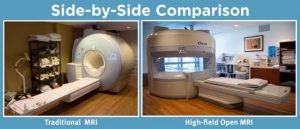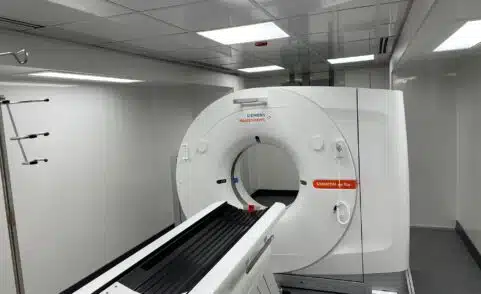
Insider Tricks to Help You Forget Your MRI Fears
Every time he bent or twisted his knee, Michael Flaherty felt sharp pain. He got hurt on the job and his doctor needed a scan to decide what to do next. While Michael was worrying about surgery, he was also feeling uneasy about the MRI. But when he arrived at RAYUS’s Dedham, MA center he relaxed. The technologist (or “tech”) who helped him through the exam showed him the High-field Open MRI where he would get his scan. It didn’t look at all like a traditional MRI machine.
“It’s almost like an open middle that you slide right in,” Michael says. “It’s not really tight and claustrophobic like you would think.”
After getting the scan, Michael described the experience as more “comfortable” and “easy-going” than he expected. His fears, it turned out, were unfounded. Open MRI tech Melissa West says a lot of her patients walk in for their appointments feeling more nervous than they need to be. Her first step to put patients’ fears to rest is to show them what she calls the “real” Open MRI and explain how it works. Click here to watch a video of the Real Open MRI experience.
When you look at a traditional MRI and a High-field Open MRI next to each other, the differences are clear. Melissa shows patients that the Open MRI machine she operates has no tube or tunnel. Once they see it, he says some people worry that the bulky top is going to lower on them. But in an Open MRI, the only thing that moves is the table, sliding the patient into the space between the top and bottom of the scanner.
Taking a Personal Approach
Techs have a lot of tricks up their sleeves. They see patient after patient who would rather be doing almost anything other than getting an MRI. So understanding your anxiety is the foundation of getting their job done. Melissa describes her approach:
“We help patients in any way we can. The goal is to get them through the test. And it really is different depending on the patient the approach you’re going to take. You have to really get in tune with the patient, find out what their need is. A good way to find out is asking, ‘Exactly what are you afraid of?’”
Sometimes it’s as simple as explaining how the exam works. When you get an Open MRI, you can bring in a friend or relative to sit in a chair right next to you. The design of the Open MRI allows you to reach out your arm and hold someone’s hand for reassurance. RAYUS patient Steven Gordon expected to feel claustrophobic, but what he didn’t expect was a helping hand. When he started to feel anxious, one of RAYUS’s techs pulled up a chair and held his hand through the exam. That wouldn’t have been possible in a traditional MRI. Speaking from experience, Steven says, “An Open MRI is ten times better than a closed MRI.”
Using Distractions of the Senses
While techs aren’t pulling rabbits out of hats, they do use distraction techniques just like magicians. The less you’re focused on your fears, the better you’ll do in a scan. That’s why you get a menu of options before your MRI to help distract you from worrying. In this video, tech Bethany Allen shows you your choices:
Sound: Headphones let you listen to the music of your choice and earplugs help you block out some of the MRI sounds. Some patients use both.
Sight: Sleep masks cover your eyes and block out your view. Reflective glasses use mirrors, so instead of looking up into the top of the machine, you have a view toward your toes and can see out into the room.
Smell: Research into scents prompted techs to offer aromatherapy as another distraction. Small aroma tabs stick onto your shirt and can give you a whiff of something tropical or soothing.
“People who are really claustrophobic need a distraction a lot of times or something to dull or heighten some of the senses,” explains Bethany. Though the tricks of sound, sight, and smell are simple, they can be enough to keep you calm and help you finish your scan. Click here to read about more ways to face your fears and conquer claustrophobia.

